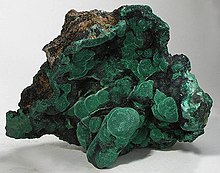
Back Bergbau in der Demokratischen Republik Kongo German Minería de República Democrática del Congo Spanish Industrie minière en république démocratique du Congo French Гірнича промисловість Демократичної Республіки Конго Ukrainian
This article needs to be updated. The reason given is: Relies a lot on old sources such as the 2001 report at https://www.globalsecurity.org/military/library/report/2001/357e.pdf. (December 2023) |

The mining industry of the Democratic Republic of the Congo (French: Industrie minière de la République Démocratique du Congo) produces copper, diamonds, tantalum, tin, gold, and more than 63% of global cobalt production.[1] Minerals and petroleum are central to the DRC's economy, making up more than 95% of the value of its exports.[2] According to a 2011 report the total value of the major mineral reserves in the DRC amounted to a total of over 300 billion US dollars at the time.[3] The mining industry in the DRC mainly consists of private, large industrial mines, semi-industrial, and artisanal mines. While private sectors take on large operations, they rely heavily on artisanal mining for extraction of resources. These industries along with non-for-profit organizations are continuously changing their guidelines as the DRC becomes more and more desirable for their valuable minerals. Mining in the DRC took place beginning in the 14th century and is still very present today, with mass scale lootings halting many major projects. The main countries involved in the mining operations in the DRC are Canada and China along with 25 other international mines active in the area. While technological companies strive for sustainable production and consumption of their products using cobalt, this is often achieved by the work of artisanal mining in hazardous and unjust working conditions.[4] The process of mining and extraction in any area has negative impacts on the environment and those living in it, however, the DRC has faced many acts of environmental injustice including child labor under fatal conditions, exploitation of laborers, and displacement.[5]
- ^ "New initiative to support artisanal cobalt mining in the DRC". Mining Review. 2021-04-01. Retrieved 2022-10-02.
- ^ Mitchell, Jason (2022-02-15). "Kinshasa is already Africa's biggest city – could cobalt make it the richest?". Mining Technology. Retrieved 2022-10-03.
- ^ Geenen, Sara (2011). "Local Livelihoods, Global Interests and the State in the Congolese Mining Sector". Natural Resources and Local Livelihoods in the Great Lakes Region of Africa. pp. 149–169. doi:10.1057/9780230304994_8. ISBN 978-1-349-33143-7.
- ^ Cite error: The named reference
:0was invoked but never defined (see the help page). - ^ Udell, Joe (2023). "Environmental Destruction and Human Rights Abuses in the Democratic Republic of the Congo: Examining the Epicenter of the Cobalt Mining Industry from an International Criminal Law Perspective". Minnesota Journal of International Law. 32 (1): 197–238.
© MMXXIII Rich X Search. We shall prevail. All rights reserved. Rich X Search